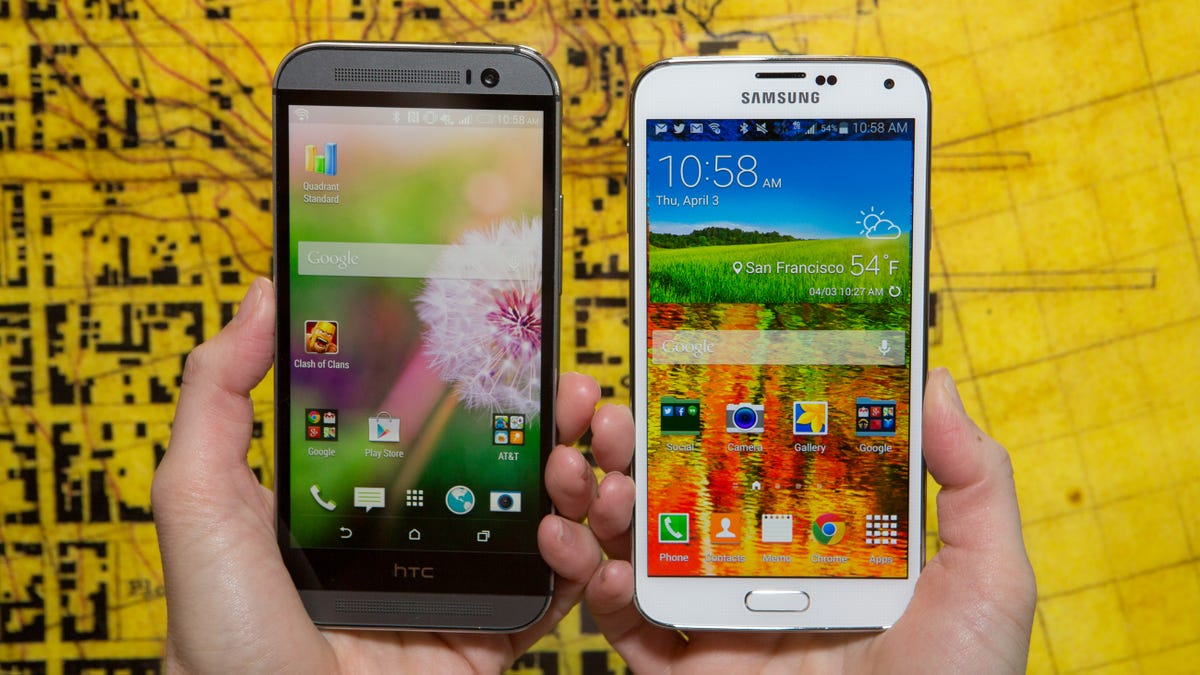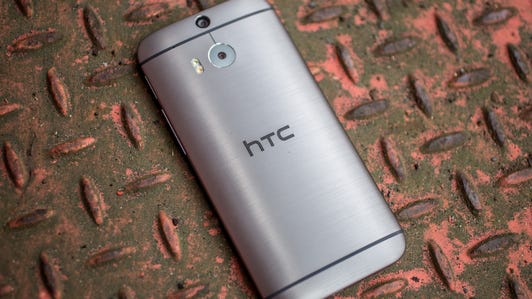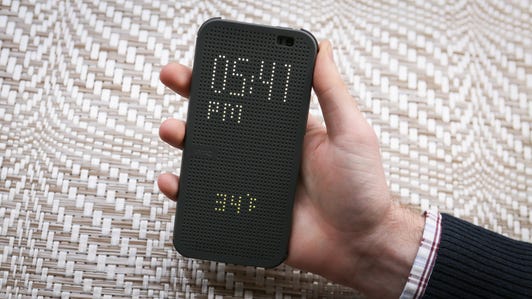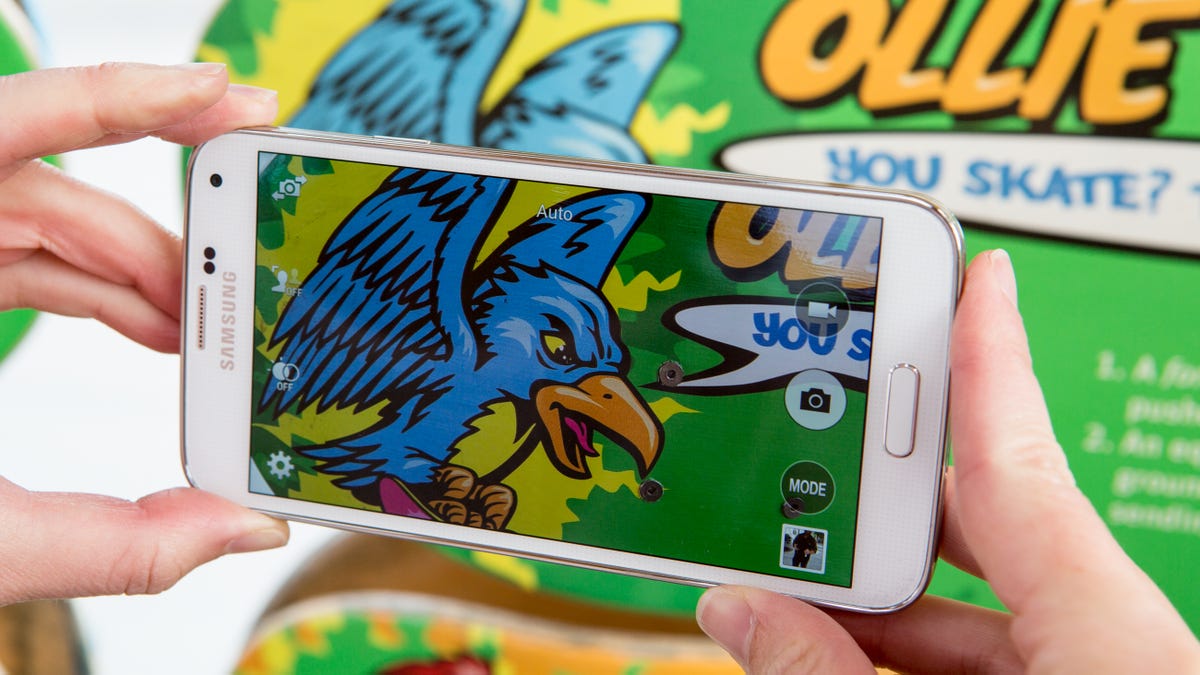
Josh Miller/CNET
The HTC One M8 , HTC’s successor to its well-received One, has stepped confidentially into the light of day with top-notch specs, a return of the lush metal body, and a new rose gold shade.
All about the HTC One M8
- Fully reviewed: HTC One M8
- Dive deep into the HTC One M8’s camera
- HTC One M8 vs. Galaxy S5 vs. iPhone 5S
- HTC One M8 BoomSound speakers are loud and proud
There are probably three big questions on your Android-deliberating mind: if the One M8 is worthy (it is, and we review it fully here ), if it is good enough to best the Samsung Galaxy S5 (not quite), and if any of that matters in the face of Samsung’s advertising juggernaut (it doesn’t look good).
Now that I’ve fully reviewed the Galaxy S5, it’s time for some side-by-side real-world comparisons.
This new HTC One doesn’t match the GS5 feature-for-feature — especially when it comes to Samsung’s hardware and software extras — but I argue that it has the stuff to make you think twice about getting the Galaxy S5, and also LG’s G Pro 2 , for that matter.
Superior build
HTC is one of those vendors synonymous with stunning design and careful construction. In what is essentially a repeat of last year’s fight between the original HTC One and Samsung Galaxy S4, HTC flashes slight seams and a higher-quality all-metal body in the face of the Galaxy S5’s basic plastic parts.
It also helps that the new One’s aluminum build gently curves in the back, which helps nestle it into your palm. Only the dark gray shade has the brushed sheen of last year’s model, but all three metallic hues share just enough gleam and weight to feel next-level premium alongside the GS5.
Check out the sleek, metal HTC One M8 (photos)






I’d like to stress that there’s nothing wrong with the S5 — the dimpled backing is pretty easy on the eye and I especially like the copper and blue colors (which won’t be sold in the US at launch). The matte finish also has a little luster, and cuts back on both glare and gummy fingerprints. The Galaxy S5 is just fine to hold and behold; HTC’s handset design just flies higher and achieves more.
Rich take on Android
I’ve always enjoyed HTC’s interpretation of Android, and Sense 6.0 continues in the same vein with just a few variations on Sense 5.0. The interface looks rich and lush with clean, stylish graphics and font that come across modern without being sterile, screenshots show.
A few tiny changes include releasing the BlinkFeed newsfeed from its previous position as the default home screen, and adding color-coordinated UI themes, a nice touch. I also like that you can double-tap the screen to wake the device (like LG’s G Pro 2), and swipe in various gestures to unlock the screen straight to select apps. For its part, Samsung’s slightly revised TouchWiz interface also cleans up, and the interface is easy to navigate.
A closer look at the HTC One M8’s features (pictures)






Samsung still piles the most customizations on top of Android, like Smart Stay and a heap of motion gestures. For basic functions, though, I’m personally more drawn to HTC’s interface.
Core hardware
Both the M8 and Galaxy S5 are packed with high-flying specs. Samsung’s phone does have the slight upper hand when it comes to the higher capacity processor, battery, and camera specs, though the M8 has the much higher-resolution front-facing camera and slightly higher pixel density. (Compare the specs here.)
A major benefit for HTC’s phone is its inclusion of a microSD slot that can store up to 128GB. This is huge step for the M8 versus the original One, and a frequently-cited reason why some buyers shunned that phone. It’s worth noting, though, that HTC keeps to its embedded battery, another sticking point for some. It’s a trade-off between the seamless all-metal unibody design or a battery you can pop out.


Now playing:
Watch this:
HTC One M8 has style, speed, and two lenses
4:44
The camera front is one of the areas where the Galaxy S5 pulls ahead. While the M8’s 4-Ultrapixel camera takes nice shots in a variety of lighting conditions, the images were “soft” compared to the Galxy S5 and the iPhone 5S. Colors weren’t quite true-to-life and the phone often overexposed the background. The contrast ratio was also notably weaker. The One M8 does have the higher-resolution front-facing camera, however, and there are plenty of modes and effects — like selective focus, 3D effect, HDR, the return of the Zoe video feature, and the ability to record HD 1080p HD video at 60 frames per second.
Samsung’s Galaxy S5, on the other hand, takes consistently detailed images that get colors right and keep contrast ratios high. Low light is much improved over past Samsung phones, and there are a ton of extra features, like a selective focus mode of Samsung’s own, and carry-over from last year’s model, like the ability to take photos with both the front and rear cameras. Samsung has one other boast, that its camera shoots 4K video rather than 1080p HD video. Still, all videos default to 1080p HD.
One other place where HTC shines is with the stereo speakers flanking the screen. Named BoomSound, audio quality here gets a bigger boost from the HTC One, which already provided some of the best audio quality we’ve heard. The Galaxy S5’s audio output smothers itself with its speaker on the back, and speakerphone quality was scratchy and indistinct.
Notable extras
Samsung once again comes out on top when it comes to gee-whiz features like the fingerprint scanner and heart-rate monitor, and those are indeed feature extras that HTC’s M8 doesn’t even begin to offer (even though the HTC One Max has a fingerprint scanner of its own). I personally find both of these niche, and not significant enough to sway my decision one way or another (especially since the scanner is finicky and inconsistent).
Exploring the Galaxy S5’s features (pictures)






Still, HTC does have its own shortcut for unlocked the screen, a double-tap like the LG G Pro 2. This is all part of the Motion Launch cluster of screen and voice gestures you can use. Both flagships fold in IR blasters for controlling the TV.
The bloatware question
“Bloatware” describes the extracurricular apps and features that carriers and manufacturers put on a phone, but the line dividing what’s useful from what’s extraneous is a personal one. The HTC One M8 seems to have fewer HTC-made apps, though we’ll need to get both phones of the same US carrier version next to each other to determine which one gives you the most free storage.
Pricing and capacity
Same as last year’s models, the 32GB HTC One M8 costs about the same as the 16GB Galaxy S5. In the US, that’s $200 on contract, and between $600 and $650 at full retail price. However, There’s no question that HTC’s 32GB phone delivers better value in the capacity department than the 16GB model that Samsung sells for the listed retail price. (The company does also make a 32GB capacity, which may sell in certain markets or through specialty distributors.) Outside the US, Samsung’s phone costs significantly more than the HTC One M8. In the UK, for instance, the M8 costs £100 less.
Head-to-head
So how is the new HTC One compared to the Galaxy S5? In the areas that matter most to me — design, camera, and performance — the HTC One M8 was on par with the S5, except for the camera functionality, which was slightly wanting. Photo supremacy doesn’t matter to everyone, and the M8’s photos still definitely qualify as “good.”


Josh Miller/CNET
It’s this phone’s premium hardware design, lush interface aesthetic, and strong external speaker quality that add up to a flagship device deserving of its place near the top of the heap. The phone may not have all of Samsung’s frippery, but it does the basics very well.
On the other hand, Samsung’s Galaxy S5 has the removable battery, the better camera, and the more numerous hardware and software features — including the first heart rate monitor we’ve seen on a smartphone. More importantly to the phone’s ultimate success, it also has Samsung’s formidable marketing might, which can drown rivals like the more cash-scarce HTC in its messaging.
The sparkling new HTC One is certainly worth your consideration, and its hardware gives Samsung’s the chase. Unfortunately for HTC, this may matter little when faced with the bulldozer of Samsung’s surpassing camera quality and unignorable marketing momentum.



